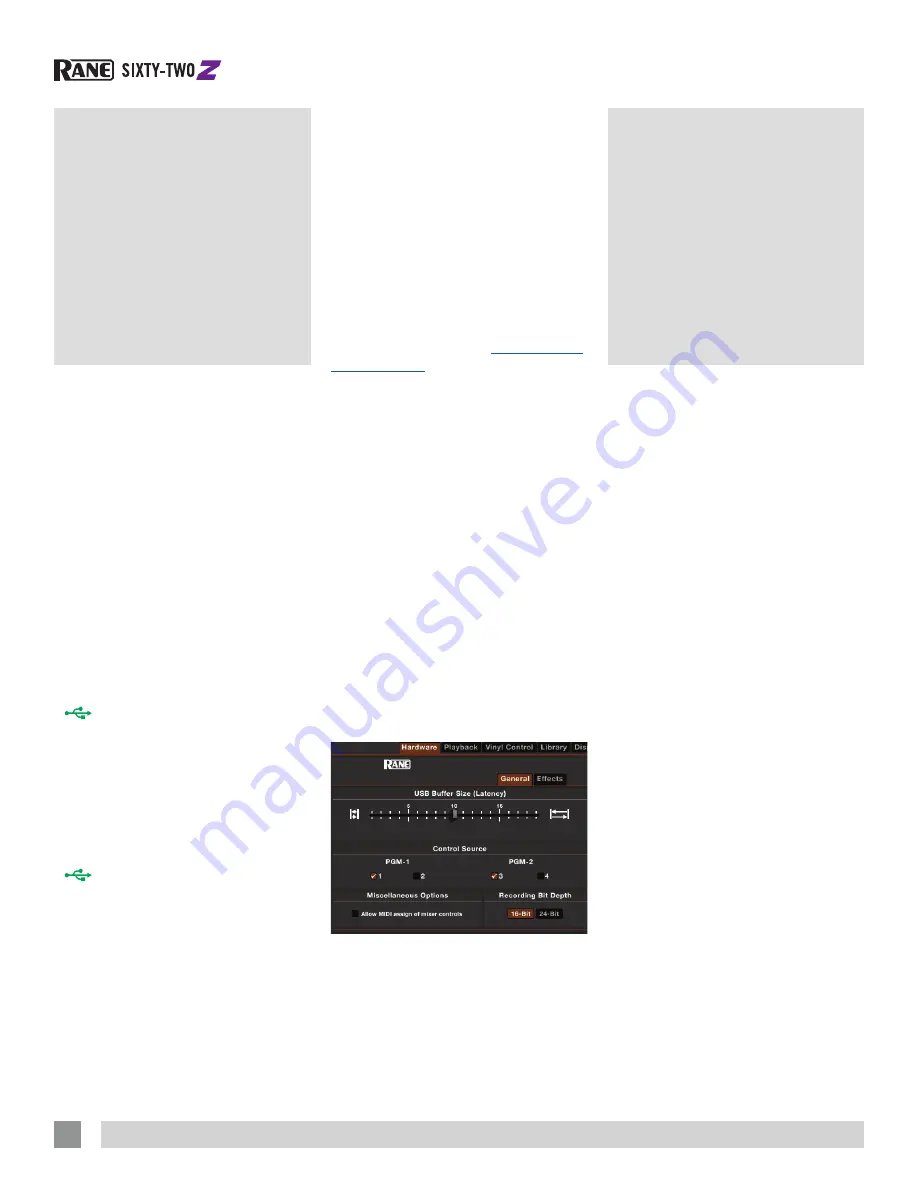
RANE SIXTY-TWO Z MIXER FOR SERATO SCRATCH LIVE • QUICK START
2
Calibrating
Scratch Live
This guide will help you get your decks
connected and music playing. Turn the
power off while connecting your decks
and amplifiers.
Analog Inputs
1. Connect your Left deck’s RCA cables to
AnAlog Input 1
.
•
If it’s a CD player, select
CD
with the
switch above the input jacks.
•
If it’s a turntable, select
pH
(Phono)
with the switch above the input jacks.
Secure the ground wire to a Phono
Ground terminal.
2. Set the
SouRCE
selector for PGM 1.
pH / CD 1
plays directly from your deck.
To play from Scratch Live, choose
A
.
3. Connect your Right deck’s RCA cables
to
AnAlog Input 3
.
•
Select
CD
or
pH
as in step 1.
4. Set the
SouRCE
selector for PGM 2.
pH / CD 3
plays directly from your deck.
To play from Scratch Live, choose
A
.
Analog Outputs
•
Main Out
is on a pair of balanced
XLR jacks with pin 2 “hot” per AES
standards.
•
Booth Out
is on a pair of balanced ¼˝
TRS jacks.
•
Session Out
is available on a pair of
unbalanced RCA jacks.
•
Headphones
output is available on both
¼˝ TRS and 3.5 mm jacks.
The Main, Booth and Session outputs
come from the same “Main Mix” signal.
Main, Booth and Session outputs each
have their own Level control. Because
all signals are identical, you may use any
of these outputs as the “Main” output if
a different cable is required for system
connection.
Rane recommends balanced wiring for
the strongest signal and rejection of hum
and noise. If your cable to the destination
is less than 10 feet (3 meters), you can
often get away with an unbalanced
cable. See the RaneNote “
Sound System
Interconnection
” at rane.com for cable
wiring recommendations.
USB Control Source
The default Inputs for decks performing
Digital Vinyl Simulation (DVS) are Inputs
1 and 3, but you can change this. Analog
Input 1 or 2 may be selected in Scratch
Live software as the DVS signal for the
Left Virtual Deck. Analog Input 3 or 4 may
be selected in software as the DVS signal
for the Right Virtual Deck.
To select the control sources in Scratch
Live, click the SETUP button at the top of
the Scratch Live screen. In the Hardware
> General tab, verify that Control Source >
PGM 1 is set to “1”. This will be your Left
Virtual Deck. verify that Control Source >
PGM 2 is set to “3”. This will be your Right
Virtual Deck.
Since Scratch Live is controlled by an
analog signal, there is no guarantee of
what state that signal will be in by the time
the software gets to interpret it. Therefore,
Scratch Live needs to be able to handle a
wide range of signals, and be configurable
to use them optimally. Calibrating is just
configuring the software to your situation.
Calibration is equally important for both
vinyl and CD users of Scratch Live.
There are two parts to the Scratch Live
control signal: The directional tone, and
the noise map. Listening to the control
vinyl, the directional tone is the 1 kHz
tone. The noise map sounds like random
noise over the top of the tone.
The directional tone provides the
current speed and direction of the record,
while the noise map tells the software
precisely where on the record the needle
is currently.
The Noise Threshold
A threshold is a lower limit, below which
a process will not occur. In the case of
Scratch Live, the noise threshold is the
limit below which the input signal will not
be interpreted as control signal; in other
words if it’s below the threshold, it is
considered noise and ignored.
This setting is necessary because a
stylus is very sensitive, and will inevitably
pick up noise from the environment as
well as the signal on the record, especially
in the noisy environment of a live show.
Connections








